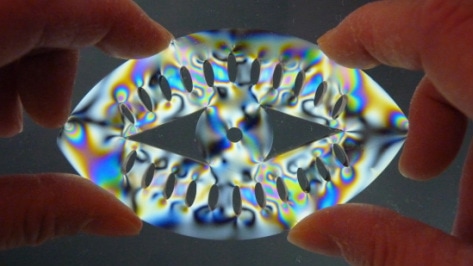Introduction To Photoelasticity
Why Rainbows are Hiding in Plastics
|
Goals:
|
Find Fun Hands On Supplies in Your Kits:
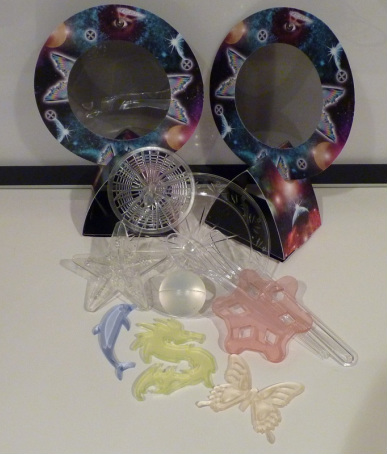
What you need:
1. Clear or Translucent plastic items (ie plastic plates, cup, knives, spoons, forks, decorations, etc.)
2. Glitterins Soft Flexible Prism Toys
3. Polarizing films
Use Two Magic Green Portals as shown in the image to the left
OR
--Magic Green Portal with Magic Glasses
--Magic Glasses with clear blue sky
--Magic Green Portal ring and clear blue sky
--Magic Green Portal ring and computer screen
-- Magic Glasses and computer screen
4. Light souce: can be ambient light
1. Clear or Translucent plastic items (ie plastic plates, cup, knives, spoons, forks, decorations, etc.)
2. Glitterins Soft Flexible Prism Toys
3. Polarizing films
Use Two Magic Green Portals as shown in the image to the left
OR
--Magic Green Portal with Magic Glasses
--Magic Glasses with clear blue sky
--Magic Green Portal ring and clear blue sky
--Magic Green Portal ring and computer screen
-- Magic Glasses and computer screen
4. Light souce: can be ambient light
Directions:
For simplicity we will use the set up of two Magic Green Portals in the Vertical Position.
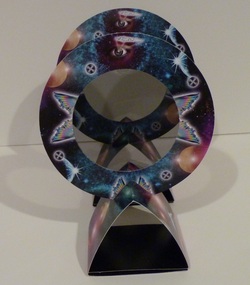
Construct two Magic Green Portals in the Vertical Position and place one in front of the other. Instructions for doing this is within the video below.
Vertical Setup with Two Magic Green Portals
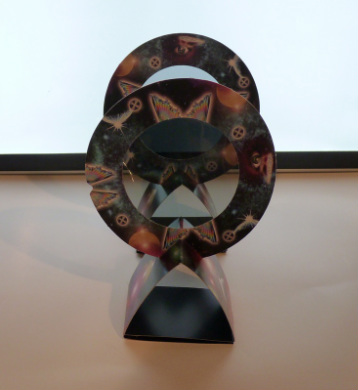
Place the Magic Green Portals in the Crossed position with respect to each other. This can be done by having the eye on one portal ring positioned on top and the eye on the other portal ring positioned directly to the left or right side of the ring. You are now ready to explore Photoelasticity. You can also place a light diffuser in back of the the portal ring behind the first ring. This will reduce background distraction.
Clear Plastic Plates and Utensils
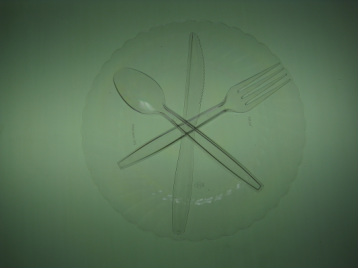
If you are a teacher, tell your class that there is a very special secret about plastics.
Here are the Above Clear plastic plates and utensils under polarized light.
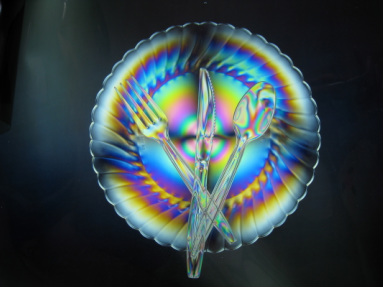
Here is the secret about plastics. Rainbows are hiding in them.
Why are rainbows hidding in plastics?
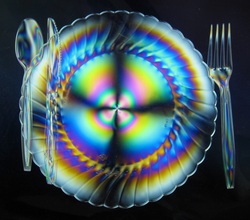
This is because of a very special property that many plastics have called Photoelasticity. When certain plastics are veiwed under polarized light they show prismatic rainbow colors due to areas of "strain" within the plastic. "Strain" is the result of "stress" or "load" that is applied to a material. If you take a rubber band and stretch it, you are applying a "load" to the rubber band resulting in "stress". The amount that the rubber band stretches in relation to the amount of "load" or "stress" that you put on the rubber band in stretching it produces strain.
stress = load/area Strain = change in length/length
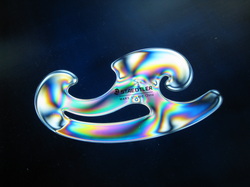
The more a material has been stretched, the more it is strained. A rubber band about to break is stretched nearly to its limit and so is at near maximun strain from the applied stress. If a material has more strain in certain areas, that means that the material has stretched more within those areas as a result of load applied. A material that has been stretched near its maximum ability to keep from breaking is more likely to break when more load is applied. Areas of greater strain are vulnerable areas where a stucture might break. The technical definition of stress is load divided by the area of the material on which the load is applied. The techical definition of strain is the change in length of a material undergoing a load divided by the original length of the material before the load is applied.
The science helps engineers. The beauty Inspires art.
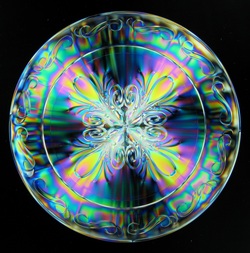
Engineers needed a tool that would help them see the areas where a structure might break. They needed to see where high concentrations of strain might be in a structure. Photoelasticity was the right tool. Under polarized light plastics that have this special property will reveal areas of strain within a structure in the form of the colorful light fringes. One need only make a representation of that structure out of photoelastic plastic and apply load. Areas of strain from the applied stress will concentrate more where the structure is most vulnverable to breakage. More colorful light fringes will be detected in these areas.
When such a structure created by photoelastic plastic is viewed under polarized light while undergoing stress, rainbow colored fringes will form and they will form much more abundantly around areas of greater strain. Here is how it works. See below:
When such a structure created by photoelastic plastic is viewed under polarized light while undergoing stress, rainbow colored fringes will form and they will form much more abundantly around areas of greater strain. Here is how it works. See below:
Illustration of the set up you made with the Magic Green Portals with the plastic in between.
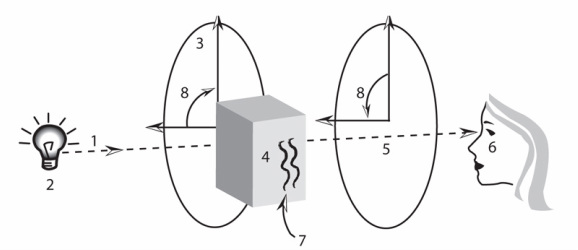
See figure to your left. We start with ordinary light, labeled (1), like that from a light bulb or sunlight from your window, labeled 2. The ordinary light passes through a special kind of film called polarizing film, labeled (3). The special film polarizes ordinary light just before it reaches into a piece of Photoelastic plastic labeled (4). This is the first necessary step in order to see rainbows in the plastic. The next step is that the polarized light that passes through the plastic piece, labeled (4), must again pass through a second Polarizing film, labeled (5), before it gets to your eye, labeled (6). If the plastic has no strain patterns within them, a load will need to be applied to the plastic piece (4) in order to generate the strain patterns within the plastic. Without strain patterns, no rainbow colors labeled (7), will appear.
You need two films (that means two portal rings or the glasses and one portal ring). Other polarizing sources such as the sky, the surface of the pond, or shiny surfaces with a glare can replace the need for one of films.
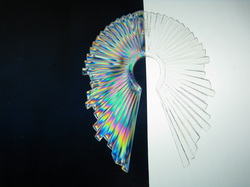
To the left is an image of a plastic ornament where one side of it (left)is between two crossed polarizing films and the other side (right) is in front of one of the polarizing films. Photoelastic colors are revealed in the plastic when it is between the two films (left side of ornament) and the colors are unseen when only one film is involved (right side of ornament). You need two films to see the colors, one in front and one behind the plastic object.
Explore. create your own experiments.
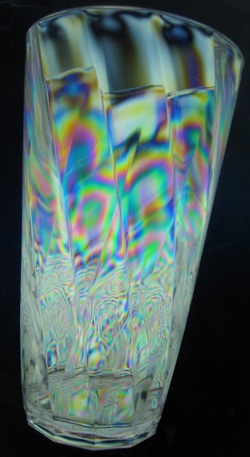
Many plastic items found around your home or in stores will show rainbow colors under polarized light without the need for applying a load or stressing them. This is because most plastic products are manufactured by a process called injection molding like the plastic glass to your left. During injection molding a plastic glass, plate, knife, spoon, or fork for example will start off as a very hot liquid plastic that is cooled quickly under compression into a mold to make its shape. This produces stress to the material resulting in patterns of strain that remain frozen within the plastic object once it cools and hardens into its shape. This is why you do not need to apply load to see the colors within plastic opjects created by injection molding. However, if you take for example, a plastic fork and carefully bend the prongs you can see the colors move around when you do it. This would be because you are affecting the strain pattern by applying load.
Many plastics, cellophane, adhesive tape, clear rubbery materials like rubber cement, and gelatin, can be used to demonstrate this fun property of photoelasticity. Another property is birefringence and materials like mica and ice chips have this property. See hidden rainbows tab for more fun ideas.
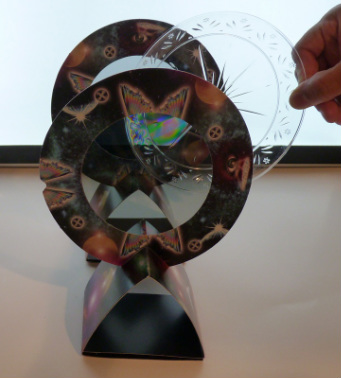
If you are a teacher, have the class select plastic items to place between the two Magic Green Portals with the films in the crossed position with respect to one another. They can also bring items from home to experiment with. Have them check out all kinds of plastics including cellophane wrappings and blister packages. Packaging materials on or within the Glitterins Toys can also be explored.
The chemistry behind photoelasticity.
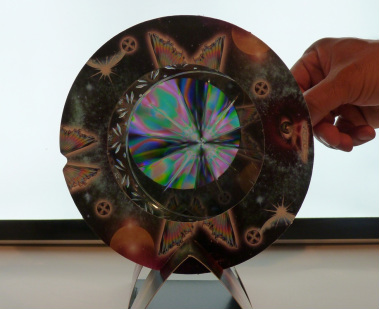
The chemical building blocks of photoelastic materials are long chains of molecules (polymers) that are usually organic in nature such as that found in proteins like gelatin. Plastics are made from organic material, namely petroleum, which is oil formed over millions of years from the remains of living things buried deep within the earth. Most of these living things were sea creatures, especially microscopic algae and plankton. When these small creatures died, layers of earth built up over them producing high temperatures and pressures that converted their remains into oil. Even though plastics are organically based, most are not biodegradable. They can remain in landfills, in our soil, and in our seas for over 400 years. Scientists are now trying to make biodegradable plastics. We should recycle our plastics, use them as much as we can before disposing them, and use biodegradable plastics whenever we can. After all, plastics are special. Rainbows are hiding in them.
Slowly molded plastics have no strain and so show no rainbow colors until load is applied by bending, stretching, twisting, or squeezing them
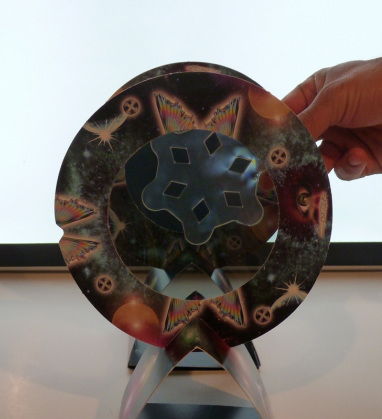
Teachers tell your class that you are now going to show them plastic that has not been made by injection molding. It has been slowing cured so that there are no patterns of strain within the plastic. Ask them if they expect to see any rainbow colors. Take one of the Glitterins plastic toys and hold it between the two Magic Green Portals that are still in the crossed position with repect to each other. Apply no stress to it. Only lightly hold it in position careful not to apply any force or load on it. Note that no rainbow colors can been seen. This is because these Glitterins toys are not injection molded but slowly cured in a mold. They were poured into a mold to give it its shape and allowed to gradually cool down and harden. Therefore no patterns of strain have been frozen into the plastic toy and so no rainbow colors are seen. However, what happens if you squeeze, bend, stretch, or twist the plastic toy? these actions will apply load to the toy producing stress resulting in strain patterns within the plastic toy. Will you see rainbows then?
Light Stress = some color
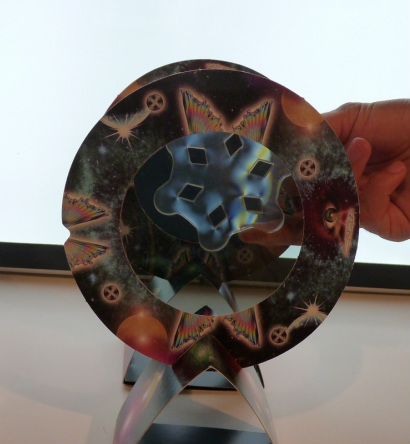
Apply light stress to the Glitterins toy and note that some rainbow colors are forming. Light stress is producing some colors.
MOre stress = more color
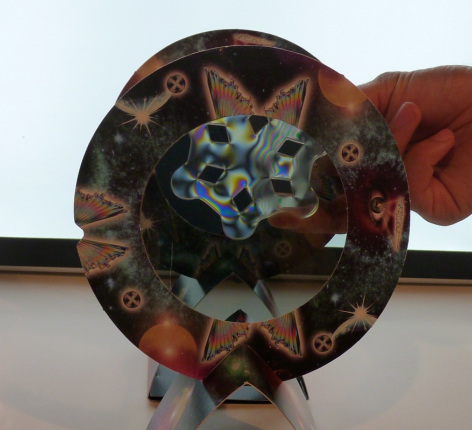
Apply more stress and point out that more stress produces more colors. Note that each toy has a different pattern of rainbow colors. Ask why this might be. Note that there are more colors around sharp corners and holes in the toys. Why would this be?
For a dynamic presentation see video below.
For a dynamic presentation see video below.
Properties of Light
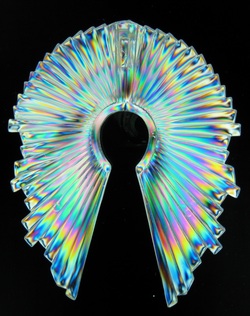
Where do all the colors come from that we see in the plastics after light is polarized?
Light is an electromagnetic wave and visible white light is composed of many electromagnetic wave frequencies each of which produces a different color on the human eye. When when white light is bent by a prism, the different colors (frequencies) of light are separated out so that you can see them. The distortions produced within photoelastic plastic by strain work like a prism on the white light. These areas rotate light separating out its frequencies. This is hard to see because of the overwhelming intensity of the white light vibrating in all directions passing through the clear plastic. Polarizing films in the crossed position block out this intense white light so that the patterned areas of separated light within the plastic can be seen.
The more we learn about light, the more questions we have. What is light made up? What is light?
Are there questions that you would like to find answers to? Will you help us learn more about the mystery of rainbow colors, the magic of light, and the hidden world of molecules and how they play with light? Scientists today continue to ponder these questions. Perhaps you will enlighten us still more.
Light is an electromagnetic wave and visible white light is composed of many electromagnetic wave frequencies each of which produces a different color on the human eye. When when white light is bent by a prism, the different colors (frequencies) of light are separated out so that you can see them. The distortions produced within photoelastic plastic by strain work like a prism on the white light. These areas rotate light separating out its frequencies. This is hard to see because of the overwhelming intensity of the white light vibrating in all directions passing through the clear plastic. Polarizing films in the crossed position block out this intense white light so that the patterned areas of separated light within the plastic can be seen.
The more we learn about light, the more questions we have. What is light made up? What is light?
Are there questions that you would like to find answers to? Will you help us learn more about the mystery of rainbow colors, the magic of light, and the hidden world of molecules and how they play with light? Scientists today continue to ponder these questions. Perhaps you will enlighten us still more.

